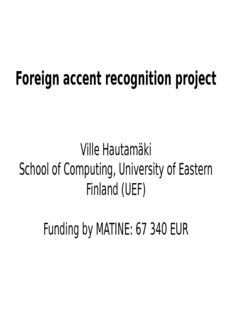
Foreign accent recognition project PDF
Preview Foreign accent recognition project
Foreign accent recognition project Ville Hautamäki School of Computing, University of Eastern Finland (UEF) Funding by MATINE: 67 340 EUR Speech @ UEF (1/2) Project PI: Dr. Ville Hautamäki: Had Academy of Finland post-doc project on the same topic. PhD Students: Hamid Behravan Foreign accent recognition backend classifier work. Ivan Kukanov Deep learning (convolutive neural networks, etc) Msc Student: Trung Ngo Trong Deep learning (long-short term memory, etc) Bsc Students: Anssi Kanervisto & Hannu Sillanpää Speech @ UEF (2/2) PI Dr. Tomi Kinnunen + 1 post-doc + 3 PhD ● students. Speaker recognition projects ● – Access control and anti-spoofing OCTAVE H2020 project (innovation action) – Audio-visual anti-spoofing biometric recogntion project BIOSECURE, Academy of Finland funded Soft-biometrics from speech signal We recognize some speaker characteristics: Age ● Language ● Accent ● Identity ● Gender ● Identity verification in border control Can we verify the passport identity without the chip and biometric reader? Soft biometrics is our approach. In passport we have written information about country of origin, age etc. Foreign accent in border control The proposed system should be assistive to border control officers. If passport says that traveler mother tongue is French but the system says that it is unlikely true then it should alert the officer. Research questions Can we improve recognition accuracy by the use of deep learning? Note that this task is inherently difficult! Would the deployed system be useful in practice? How to evaluate the system performance? Unknown test utterance is attached with a claim, such as foreign accent is Finnish. Then we have a hypothesis H that the claim is correct 1 and an anti-hypothesis H that the claim is incorrect. 0 System can then make two types of errors: miss and false alarm (or Type I and Type II errors). Equal error rate is the operating point where these error rates are equal. Universal Speech Attributes Manner of articulation describes how the tongue, lips, jaw, and other speech organs are involved in making a sound make contact: Nasal: /m/ , /n/ Stop: /p/, /b/, /k/ Fricative: /f/, /v/, /θ/ Vowel: /a/, /e/, /i/ Approximant: /w/, /r/ Glide: /j/ And Voicing: Voicing refers to the presence or absence of vocal fold vibration. Place of articulation specifies the position at which a constriction in the vocal tract occurs. Example : /d/ Place of articulation = alveolar Manner of articulation = stop Voicing = voiced (The vocal folds are vibrating.)
Description: